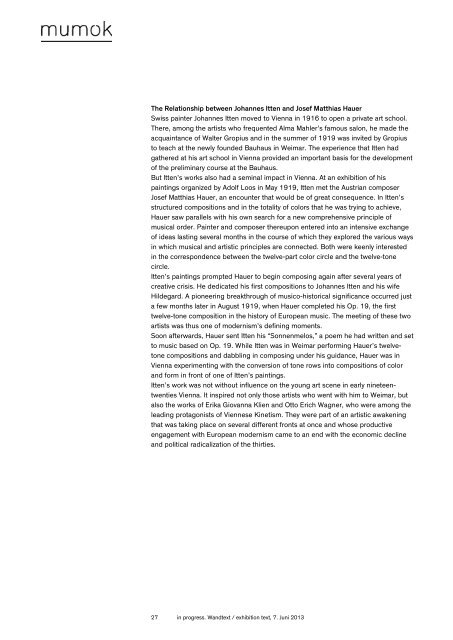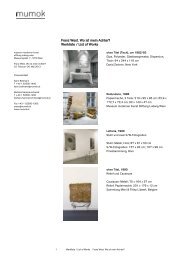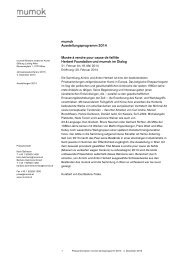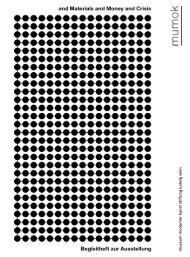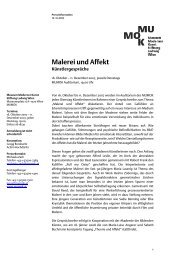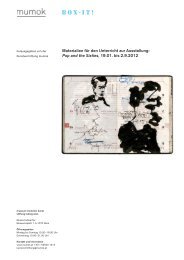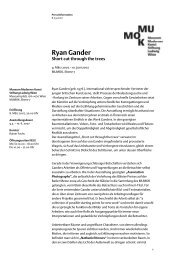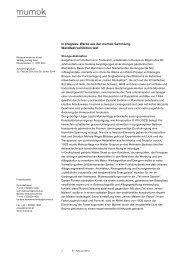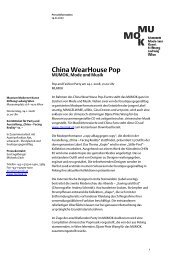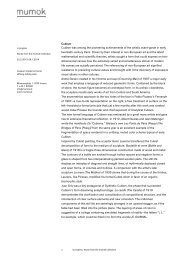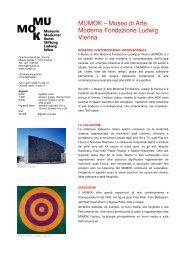in progress. Werke aus der mumok Sammlung Wandtext/exhibition text
in progress. Werke aus der mumok Sammlung Wandtext/exhibition text
in progress. Werke aus der mumok Sammlung Wandtext/exhibition text
Sie wollen auch ein ePaper? Erhöhen Sie die Reichweite Ihrer Titel.
YUMPU macht aus Druck-PDFs automatisch weboptimierte ePaper, die Google liebt.
The Relationship between Johannes Itten and Josef Matthias Hauer<br />
Swiss pa<strong>in</strong>ter Johannes Itten moved to Vienna <strong>in</strong> 1916 to open a private art school.<br />
There, among the artists who frequented Alma Mahler’s famous salon, he made the<br />
acqua<strong>in</strong>tance of Walter Gropius and <strong>in</strong> the summer of 1919 was <strong>in</strong>vited by Gropius<br />
to teach at the newly founded Bauh<strong>aus</strong> <strong>in</strong> Weimar. The experience that Itten had<br />
gathered at his art school <strong>in</strong> Vienna provided an important basis for the development<br />
of the prelim<strong>in</strong>ary course at the Bauh<strong>aus</strong>.<br />
But Itten’s works also had a sem<strong>in</strong>al impact <strong>in</strong> Vienna. At an <strong>exhibition</strong> of his<br />
pa<strong>in</strong>t<strong>in</strong>gs organized by Adolf Loos <strong>in</strong> May 1919, Itten met the Austrian composer<br />
Josef Matthias Hauer, an encounter that would be of great consequence. In Itten’s<br />
structured compositions and <strong>in</strong> the totality of colors that he was try<strong>in</strong>g to achieve,<br />
Hauer saw parallels with his own search for a new comprehensive pr<strong>in</strong>ciple of<br />
musical or<strong>der</strong>. Pa<strong>in</strong>ter and composer thereupon entered <strong>in</strong>to an <strong>in</strong>tensive exchange<br />
of ideas last<strong>in</strong>g several months <strong>in</strong> the course of which they explored the various ways<br />
<strong>in</strong> which musical and artistic pr<strong>in</strong>ciples are connected. Both were keenly <strong>in</strong>terested<br />
<strong>in</strong> the correspondence between the twelve-part color circle and the twelve-tone<br />
circle.<br />
Itten’s pa<strong>in</strong>t<strong>in</strong>gs prompted Hauer to beg<strong>in</strong> compos<strong>in</strong>g aga<strong>in</strong> after several years of<br />
creative crisis. He dedicated his first compositions to Johannes Itten and his wife<br />
Hildegard. A pioneer<strong>in</strong>g breakthrough of musico-historical significance occurred just<br />
a few months later <strong>in</strong> August 1919, when Hauer completed his Op. 19, the first<br />
twelve-tone composition <strong>in</strong> the history of European music. The meet<strong>in</strong>g of these two<br />
artists was thus one of mo<strong>der</strong>nism’s def<strong>in</strong><strong>in</strong>g moments.<br />
Soon afterwards, Hauer sent Itten his “Sonnenmelos,” a poem he had written and set<br />
to music based on Op. 19. While Itten was <strong>in</strong> Weimar perform<strong>in</strong>g Hauer’s twelvetone<br />
compositions and dabbl<strong>in</strong>g <strong>in</strong> compos<strong>in</strong>g un<strong>der</strong> his guidance, Hauer was <strong>in</strong><br />
Vienna experiment<strong>in</strong>g with the conversion of tone rows <strong>in</strong>to compositions of color<br />
and form <strong>in</strong> front of one of Itten’s pa<strong>in</strong>t<strong>in</strong>gs.<br />
Itten’s work was not without <strong>in</strong>fluence on the young art scene <strong>in</strong> early n<strong>in</strong>eteentwenties<br />
Vienna. It <strong>in</strong>spired not only those artists who went with him to Weimar, but<br />
also the works of Erika Giovanna Klien and Otto Erich Wagner, who were among the<br />
lead<strong>in</strong>g protagonists of Viennese K<strong>in</strong>etism. They were part of an artistic awaken<strong>in</strong>g<br />
that was tak<strong>in</strong>g place on several different fronts at once and whose productive<br />
engagement with European mo<strong>der</strong>nism came to an end with the economic decl<strong>in</strong>e<br />
and political radicalization of the thirties.<br />
27 <strong>in</strong> <strong>progress</strong>. <strong>Wand<strong>text</strong></strong> / <strong>exhibition</strong> <strong>text</strong>, 7. Juni 2013


